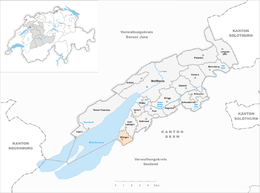Mörigen
| Mörigen | ||
|---|---|---|
 |
||
|
||
| Coordinates: 47°5.1′N 7°12.8′E / 47.0850°N 7.2133°ECoordinates: 47°5.1′N 7°12.8′E / 47.0850°N 7.2133°E | ||
| Country | Switzerland | |
| Canton | Bern | |
| District | Biel/Bienne | |
| Government | ||
| • Mayor | Camille Kuntz | |
| Area | ||
| • Total | 2.16 km2 (0.83 sq mi) | |
| Elevation | 480 m (1,570 ft) | |
| Population (Dec 2016) | ||
| • Total | 858 | |
| • Density | 400/km2 (1,000/sq mi) | |
| Postal code | 2572 | |
| SFOS number | 0742 | |
| Surrounded by | Epsach, Hermrigen, Sutz-Lattrigen, Täuffelen, Twann | |
| Website |
www SFSO statistics |
|
Mörigen is a municipality in the Biel/Bienne administrative district in the canton of Bern in Switzerland.
Mörigen is first mentioned in 1196 as Moringen.
During the Bronze Age the lake shore near modern Mörigen was home to a large Urnfield culture stilt house settlement, which probably reached its peak during the 9th century BC. The site was discovered in 1843 and after the Jura water correction dropped the water level in Lake Biel the entire site was exposed. Initially artifacts were collected by amateurs and placed in private collections. The beginning of the collections of the Schwab Museum in Biel, the Laténium in Hauterive and the Swiss National Museum all came from Mörigen.
In 1873 the Bernese government banned private excavations at the site and commissioned Edward Jenner and Edmund Fellberg to lead an expedition to carefully excavate the site. They found the remains of a settlement which was elliptical in shape and about 190 by 120 meters (620 ft × 390 ft) in size. The remains of some of the buildings and bridges were discovered. Willow wickerwork, straw, grain and plants provide an insight into how they lived and what they ate. Today there are about 1,400 bronze artifacts from Mörigen in Swiss museums along with a number in foreign countries. Refining vessels along with sandstone and clay molds provide evidence of bronze refining at Mörigen. The artifacts include 13 swords or fragments of weapons, tools, jewelry, horse bridles and crescent shaped razors based on a northern Italian style. In addition to bronze, some of the bracelets contain pieces of iron, one of the first traces of iron working in Switzerland. Ceramics and opaque glass beads have also been discovered at the site.
...
Wikipedia




